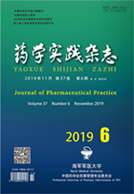-
血流感染(BSI)是我国住院患者死亡的重要原因之一,其总住院病死率为12.83%,较高的死亡率与癌症 、高龄(>60岁)、脓毒症的诊断、重症监护室(ICU)住院和BSI发病前住院时间延长显著相关,其中,腹腔感染继发的BSI为15.69%[1] 。此外,高病死率也与病原体相关,包括甲氧西林敏感性金黄色葡萄球菌、耐甲氧西林金黄色葡萄球菌、非念珠菌性真菌、念珠菌、假单胞菌及多重微生物感染[2] 。
据报道,念珠菌BSI的发病率为全球每1 000人中有0.08~1.73例,而病死率高达40%以上[3]。 其患者危险因素包括:免疫抑制剂的使用、广谱抗菌药物的应用、肠外营养治疗、入住重症监护病房和静脉置管等[4],其总体治疗原则为:棘白菌素作为初始治疗;患者达到临床稳定且血培养阴性后,可在5~7 d后换为氟康唑;定期重复进行血培养检查直至阴性;在发烧的情况下,可以间隔1 d重复抽血培养;怀疑中心静脉导管感染时,强烈建议将其拔除;血培养阴性且临床症状缓解后应继续治疗两周;不建议联合用药治疗念珠菌BSI。
中国医院侵袭性真菌监测网(CHIF-NET)2018年数据总结,我国医院真菌BSI的菌种分布中念珠菌属占91.6%,而其中光滑念珠菌占11.2%,继白色念珠菌、热带念珠菌和近平滑念珠菌之后,排在第4位。本文就一例消化道穿孔继发光滑念珠菌血流感染患者抗感染治疗的病例进行分析,以期助力医生对高危菌血症患者合理治疗的决策制定以及临床资源优化。
-
患者,男,53岁,2023-02-26因“无明显诱因下腹痛”来院,在门诊诊断为消化道穿孔后于次日入院并行开腹探查术+小肠部分切除术,术后入ICU,期间降钙素原(PCT):1.688~13.45 ng/ml、C-反应蛋白(CRP):61.8~84.55 mg/L、白细胞(WBC):11.17~20.26×109/L、白介素-6(IL-6):198.7~2 222 pg/ml,嗜中性粒细胞绝对值:8.56×109/L,结果均高于正常值,期间两次引流液培养均示光滑念珠菌(+),一次血培养:光滑念珠菌(+),芽孢杆菌属(+)。先后给予的抗感染药物包含美罗培南、万古霉素、卡泊芬净和甲硝唑,同时进行连续性肾脏替代治疗(CRRT)、肠外营养等支持治疗。2023-03-03(ICU治疗5 d后),患者的感染指标以及临床表现持续好转,且各项生命体征平稳后,转入普通病区胃肠外科。
入胃肠外科当日,痰培养示洋葱伯克霍尔德菌生长(++++),予美罗培南1 g,q8 h、万古霉素1 g,q12 h广覆盖抗感染治疗共计8日后,PCT 0.468 ng/ml 、CRP 59.19 mg/L 、WBC 11.19×109/L,且后五天持续高温38.1 ℃~39.2 ℃,疗效不佳,遂根据药敏结果,更改抗感染方案为头孢哌酮/舒巴坦(3 g,q12 h)、莫西沙星(0.4 g,qd)共计2 d后,患者体温38.9 ℃,血氧饱和度88%,仍诉咳痰困难,医生考虑可能存在念珠菌血流感染,增加氟康唑0.2 g,bid,临床药师考虑,念珠菌BSI首推荐棘白菌素类,建议更改氟康唑为卡泊芬净,医生采纳,于次日停用氟康唑,而静脉滴注注射用醋酸卡泊芬净50 mg,qd。抗真菌治疗2 d后血培养鉴定结果为光滑念珠菌生长,同时药敏实验结果显示氟康唑为中介,改为静脉滴注“注射用醋酸卡泊芬净50 mg,qd+注射用头孢哌酮钠/舒巴坦钠3 g,q8 h+盐酸莫西沙星氯化钠注射液0.4 g,qd”的方案继续抗感染治疗。
-
光滑念珠菌在人群中的定植率和感染率,随着年龄的增长而升高[5] 。除年龄外,主要危险因素还包括:大范围的胃肠道手术、侵袭性治疗手段的应用(如机械通气、中心静脉导管、导尿管等)、广谱抗生素的使用、血液透析、一些潜在的疾病(糖尿病、肿瘤患者、肾衰患者、接受移植的患者及HIV感染患者)[5-7] 。
-
2016 美国感染病学会(IDSA)《念珠菌病管理临床实践指南》指出:在非粒细胞缺乏症、中性粒细胞缺乏症或重症念珠菌血流感染患者的初始治疗中或在经验性治疗时均首选棘白菌素,而氟康唑作为备选方案,仅可用于预防性治疗或者在非重症且无耐药风险的情况下应用。氟康唑对于光滑念珠菌感染者需证实药物敏感,且剂量需加倍。《中国成人念珠菌病诊断与治疗专家共识》指出念珠菌血流感染在获得药敏试验结果前,应首选棘白菌素类,尤其是光滑念珠菌血流感染。我国ICU患者调查结果显示,光滑念珠菌对卡泊芬净无耐药[8] ;一项我国对医院进行的非白念珠菌临床分离株药敏试验结果显示,常见的4种非白念珠菌对棘白菌素类敏感性为97.7%~100%[9]。因此,本例中患者初始抗真菌治疗选用的氟康唑方案不合理。
棘白菌素类药物抗菌效果与游离药物浓度和最低抑菌浓度(MIC)之间的比值密切相关,不同菌种和感染类型可能对药代动力学—药效动力学(PK/PD)参数有不同要求。因此,在临床应用中,应根据具体菌种和感染类型选择适当的PK/PD参数,以优化治疗方案。棘白菌素类治疗念珠菌BSI的用法用量为:卡泊芬净,首剂70 mg,维持剂量50 mg/d,静脉滴注(i.v.gtt);米卡芬净,100 mg/d,i.v.gtt;阿尼芬净(国内未上市),200 mg负荷量,维持剂量100 mg/d,i.v.gtt;瑞扎芬净(待上市),400 mg负荷量,维持剂量每周200 mg,i.v.gtt。多数专家认为前3种药物治疗念珠菌BSI时可以互换,药品选择性无差异。根据我院实际情况,在药师建议下,次日医嘱停用氟康唑,启用卡泊芬净抗感染治疗。
-
卡泊芬净具有三相、非线性药物代谢动力学特征。体内研究发现卡泊芬净用于念珠菌感染时,Cmax/MIC在10~20之间显示较好疗效。另有体外研究显示,卡泊芬净对念珠菌的目标谷浓度应大于1 µg/ml[10]。通常情况下,卡泊芬净首次静脉输注之后,初始阶段组织分布引起药物血浆浓度迅速下降,而后药物由血管外组织逐渐释放回来并伴随着缓慢的肝脏代谢,终末半衰期为27~50 h。因此,为了使最初的血浆浓度在治疗范围内同时防止药物蓄积,所需的给药策略为首剂给予负荷剂量,然后是剂量稍低的一日1次的维持剂量。同时,影响血浆清除的主要机制是分布,质量平衡研究结果显示在70 mg醋酸卡泊芬净单次给药后分布良好。研究显示,对于光滑念珠菌,卡泊芬净MIC≤0.06 mg/L时,应用负荷剂量为70 mg的方案可以达到高目标获取概率(PTA)[11]。因此,负荷剂量建议70 mg,而本例中胃肠外科使用的50 mg剂量不合理。
卡泊芬净的维持剂量无需根据种族、性别、肾脏受损情况及老年病人(65岁或以上)与否而调整,而且血液透析后不需要补充剂量。但由于卡泊芬净主要通过肝脏代谢,因此说明书建议肝功能不全的患者需调整剂量:中度肝功能不全成年患者的治疗剂量:70 mg负荷剂量后,治疗剂量为35 mg,每日一次;而由于数据不足,目前严重肝功能不全成年患者(Chid-Pugh评分>9分)尚无确定的临床用药方案。
本病例患者无肝性脑病,无腹水,总胆红素38.1 μmol/L,白蛋白23.3 g/L,凝血酶原时间延长5.6 s,故Chid-Pugh评分为9分,为中度肝功能不全。因此,醋酸卡泊芬净注射液的用量应为70 mg负荷剂量,35 mg维持治疗剂量,每日1次。
-
对于非中性粒细胞缺乏患者的念珠菌血流感染,《热病》50版推荐抗菌药物的疗程是末次血培养阳性后14 d;而2016 IDSA《念珠菌病管理临床实践指南》的相关表述为:血培养转阴后须继续治疗至少2周。本例中初次治疗为2023-02-28至2023-03-03(4 d),转至胃肠外科后停用了抗真菌药,疗程不足。2023-03-13继续启用了抗真菌治疗直至转出胃肠外科(5 d),后续跟进并确认了卡泊芬净的足疗程使用。
-
真菌血流感染是临床上重大的感染,发病急、 病死率高,而高龄患者药动学、药效学参数的改变,增加了药物选择的难度。临床药师应充分发挥自身的优势,对于年龄>65岁、入住ICU、长期使用广谱抗生素及各种侵袭性操作的患者,若出现发热时,应积极留取血培养,根据患者药敏试验结果、真菌培养结果以及患者自身病情及其进展情况,合理选用抗菌药物,以达到符合临床预期的抗感染治疗效果。
该分析是关于一例消化道穿孔患者术后发生的继发念珠菌血流感染病例。在治疗过程中出现初始经验治疗选药不当、负荷剂量不足以及维持剂量偏大的情况,临床药师及时建议并被采纳:停用氟康唑而启用卡泊芬净;卡泊芬净负荷剂量的应用未能及时干预,于是再次向医生宣教卡泊芬净首剂为70 mg的用药方案;维持剂量因病人为中度肝功能不全,应为35 mg,每日一次,且应用药至血培养转阴后至少2周。此外,由于ICU期间具有棘白菌素暴露史,建议本例患者在胃肠外科使用卡泊芬净前,进行棘白菌素类药物敏感试验。
A case of postoperative candida bloodstream infection occurred in patients with digestive tract perforation
doi: 10.12206/j.issn.2097-2024.202312012
- Received Date: 2023-12-06
- Rev Recd Date: 2024-06-04
-
Key words:
- caspofungin /
- fluconazole /
- Candida infection
Abstract:
| Citation: | FENG Guangwei, ZHANG Jing, LIU Yangxi, CUI Min. A case of postoperative candida bloodstream infection occurred in patients with digestive tract perforation[J]. Journal of Pharmaceutical Practice and Service. doi: 10.12206/j.issn.2097-2024.202312012 |







 DownLoad:
DownLoad: